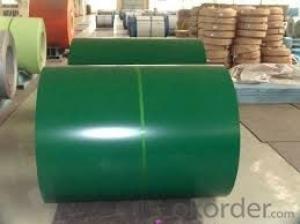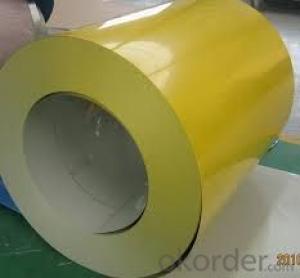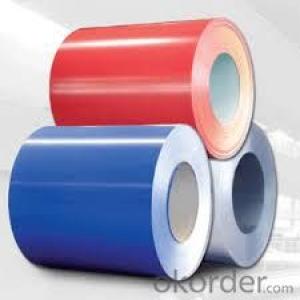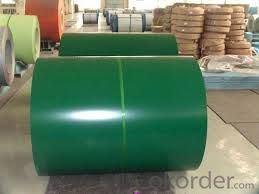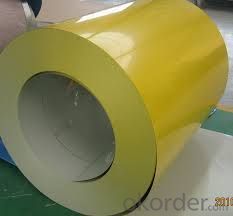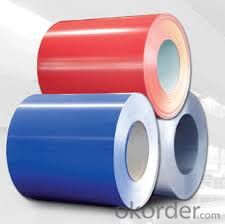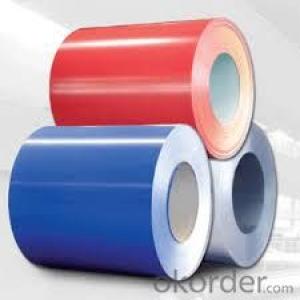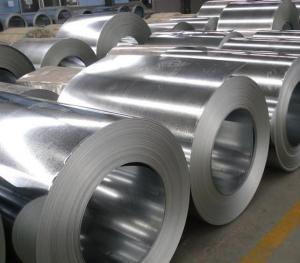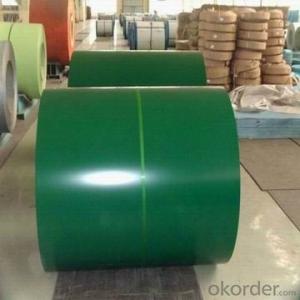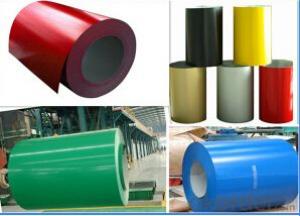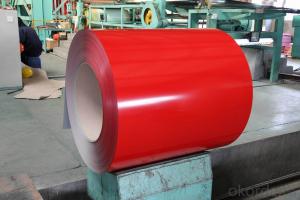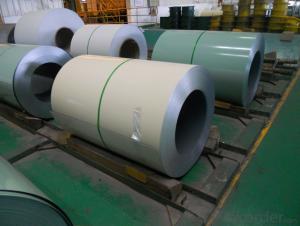PPGI Steel Coils/Color-Coated Coils/Printed Steel Coils
- Loading Port:
- Shanghai
- Payment Terms:
- TT OR LC
- Min Order Qty:
- 25 m.t.
- Supply Capability:
- 10000 m.t./month
OKorder Service Pledge
OKorder Financial Service
You Might Also Like
Product Description
manufacture for GI and PPGI .PPGI Color coated steel coil, prepainted galvanized steel coil ppgi, ppgl.
PPGI Steel Coils/Color-coated Coils/Printed steel Coils
Product Description
NAME:High Quality 0.12-1.5mm PPGI for Roof and Clad\Prepainted Steel Coil\Colour Coated Coil\Coil coated steel
SIZE:
Thickness: 0.12-1.5mm
Width: 30mm-1250mm (STD914mm,1000mm, 1200mm, 1219mm, 1250mm)
Thickness tolerance: +/-0.02mm or control in 0.1 according to customer's requirement
Width tolerance: +/-0.2mm
ZINC, PAINT & COLOR:
Zinc coating: 40-270G/M2 the mainly need is 40-60G/M2
Paint thickness: Top 20-25um + Back 7-10um
Color: As the RAL color standard or customer's sample
Hardness: normal hard (HRB 65); full hard (HRB95) or as per your request
Tensile Strength: more than 270Mpa
Yield Strength: 370-380Mpa,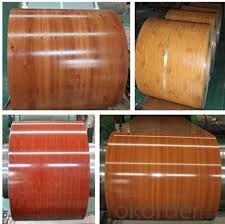
Packing:
1. Coil weight: 3-5 tons
2. Coil ID: 508mm\610mm
3. Inner side: By water proof kraft paper and plastic packing.
4. Outside: Covered by steel sheet, bundled the sheets with steel strips.
5. Standard sea worthy package or special packing method as per your request
Markets:
We has been exporting steel coils to more than 40 countries and regions directly. Our long term supply extends to Middle East, South Asia, southeast Asia, Africa and eastern Europe and so on. CNBM will be your best business partner.
STANDARD:
JIS G 3312, ASTM A755, EN10169,GB/T2518
Base sheet: Galvanized steel coils\ Galvalume steel, such as SGCC, CGCC, DX51D+Z, Q195,etc
Base metal: Hot galvanized steel or PrePainted Galvanized aLuminium steel or HBR>85
Techinque: Cold rolled, hot-dipped galvanizing, color coated
Quality: CQ DQ prime
Lifespan: 10-15 years
Payment and Delivery Time:
1. Payment: 30% T/T as deposit and 70% balance against copy b/l. Or L/C at sight
or nogotiate.
2. Delivery Time: 7-15 days in receipt of your TT deposit.
APPLICATION.
Outdoor: Roof\ Roof structure\Surface sheet of balcony\ Frame of window\Door of garage\Roller shutter door\Persian blinds\Cabana and so on.
Indoor: Door\Isolater\Frame of door\Light steel structure of house\\Folding screen\Ceiling\Internal decoration of toilet and elevator.
Building accessories: Window panels, signboards Home appliances: Oil/gas boilers, rice buckets, portable gas burners, etc.
Q&A Do you accept OA payment terms?
ANSWER:Yes, sure, but it normally depending on the order value
- Q: I've heard on some 1911 forums that the slides of Armscor guns are now extruded. What is extruded steel? How is it made? Are they strong (4140carbon steel was used in the process).
- Extrusion okorder /
- Q: I want to experiment with making steel and want to especially make it stronger. And also I want to know if its possible to turn a meteorite into steel?
- If you're looking to make steel stronger, I can suggest 2 things: 1. If you're actually smithing the steel yourself, and forging it from hot liquid metal, then if you can get ahold of some Carbon (i have no idea where you can get some), you can add it to the molten steel to make it stronger. Sword Smiths did it all the time back in the Dark Ages. (you'll have to look up the exact Science and Process of how to do it) 2. There's a treatment for steel called Tempering. If you Temper the steel, it makes it stronger. You do this by 1st Forging what you're making. In this case, I'll use a sword. Take the Sword and re-heat it (i dont know the exact temperature) until it glows-hot. You can use a blast furnace, a campfire, or any other extreme-source of heat. Some companies use molten Salt - yes, the Condement, and dip the sword in it until it's glowing-hot. Now you have to super-cool it. This is simple, all you need is Ice water. Submerge the Sword in it, until it's cool to the touch. Now toss the Sword back into your source of extreme Heat. Get it glowing hot, and then take the sowrd out. Set it aside, and let it cool naturally. Once it's cooled, it's TEMPERED, and alot stronger. NOTE: If you stop at the ICE-WATER stage, you'll only succeed in making your Sword BRITTLE. You MUST Continue the Process once Started. - Hope this helps.
- Q: How do steel coils withstand extreme temperatures?
- The unique composition and manufacturing process of steel coils enable them to endure extreme temperatures. Steel, the primary material in coils, consists of iron and carbon, forming an alloy with exceptional thermal properties. With a high melting point of up to 2,500 degrees Fahrenheit (1,370 degrees Celsius), steel remains structurally stable even in intense heat. Additionally, the annealing process is commonly applied to steel coils. This involves heating the steel to a specific temperature and gradually cooling it down. By relieving internal stresses, annealing enhances the steel's resistance to thermal expansion and contraction. It also reduces internal defects, thereby improving the overall strength and durability of the steel, enabling it to better withstand extreme temperatures. Furthermore, protective coatings are often applied to steel coils to provide additional resistance against temperature fluctuations. These coatings, such as galvanized or zinc coatings, act as a barrier between the steel and the external environment. They effectively prevent oxidation, corrosion, and other forms of degradation that can occur when exposed to extreme heat or cold. In conclusion, the ability of steel coils to withstand extreme temperatures can be attributed to the inherent properties of steel, the annealing process that relieves internal stresses, and the protective coatings that offer an extra layer of resistance. These factors work in harmony to ensure that steel coils maintain their structural stability and performance, even in the most challenging temperature conditions.
- Q: What are the common defects in steel coil surface finishes?
- Scratches, pits, rust, oil stains, and uneven coating are all common defects that can be found on the surface finishes of steel coils. Scratches are typically caused by mishandling or transportation and can significantly impact both the appearance and performance of the coil. Pits, on the other hand, are small depressions that can be attributed to various factors such as impurities in the steel or incorrect processing techniques. Rust occurs when the coil is exposed to moisture or corrosive environments, and this can compromise the structural integrity of the material. If the coil is not adequately cleaned before or after processing, oil stains may appear, leaving unattractive marks on the surface. Lastly, uneven coating can arise during the application of protective coatings or paints, resulting in varying levels of protection and aesthetics across different areas of the coil. It is crucial to address these defects to ensure the steel coil's quality and durability in its intended applications.
- Q: What are the advantages of using steel coils over other materials?
- There are several advantages of using steel coils over other materials. Firstly, steel is highly durable and has a long lifespan, making it ideal for various applications. Secondly, steel coils have excellent strength and can withstand heavy loads and extreme weather conditions. Thirdly, steel is recyclable and environmentally friendly, ensuring sustainability. Additionally, steel coils provide superior corrosion resistance, reducing maintenance costs. Lastly, steel offers versatility in terms of customization, allowing for various shapes, sizes, and thicknesses to meet specific requirements.
- Q: I have two theories, which one's correct?My book says that steel is made up of 98% iron and 2% carbon.98% of iron's molar mass (55.85 g/mol) is 54.733.2% of carbon's molar mass (12.01 g/mol) is .2402.If you add them up that gives you that steel has a molar mass of 54.97 g/mol.However, steel's chemical formula is Fe(3)CThat would make it's molar mass 179.56 g/mol.( Because 3(55.85) + 12.01 = 179.56 )Which one is correct?
- Steel is an alloy - a mixture not a compound; it doesn't have a chemical formula. Only elements and compounds have molecular weights, not mixtures that aren't composed of a uniform molecule, so neither answer is correct.
- Q: How are steel coils used in the production of metal storage systems?
- Steel coils are typically used as a primary raw material in the production of metal storage systems. These coils are unrolled and processed through various machines and equipment to form different components such as shelves, frames, and supports. The steel coils are cut, shaped, welded, and coated to ensure durability and strength. Additionally, the coils can also be used to create interlocking panels or sheets that form the walls and roofs of the storage systems. Overall, steel coils play a crucial role in the manufacturing process, providing the necessary material for the construction and assembly of metal storage systems.
- Q: How are steel coils used in the manufacturing of roofing materials?
- Steel coils are used in the manufacturing of roofing materials by being processed and shaped into various forms such as sheets, shingles, or panels. These coils are typically coated with protective layers to enhance durability and resistance to corrosion. The coils are then cut, formed, and assembled to create the final roofing product, ensuring strength, reliability, and longevity for the roofs.
- Q: i know theres steel in it but what else?
- Corosion Resistant steel..... It does corrode... just at a slower rate then normal steel.
- Q: What is the lifespan of a steel coil?
- The lifespan of a steel coil can vary depending on various factors such as the quality of the steel, its usage and maintenance. However, on average, a well-maintained steel coil can last anywhere from 10 to 30 years.
Send your message to us
PPGI Steel Coils/Color-Coated Coils/Printed Steel Coils
- Loading Port:
- Shanghai
- Payment Terms:
- TT OR LC
- Min Order Qty:
- 25 m.t.
- Supply Capability:
- 10000 m.t./month
OKorder Service Pledge
OKorder Financial Service
Similar products
Hot products
Hot Searches
Related keywords
